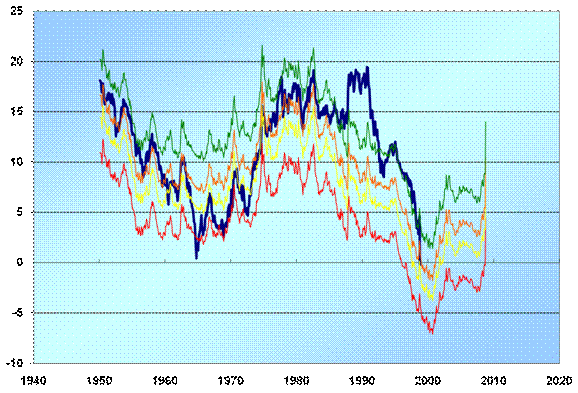Wed 10 Dec 2008
Chrysler is trying to claim that “it’s not a bailout.” Their homepage:

This is obviously a PR move to gain sympathy with the financially illiterate, but quite frankly it is disappointing and a sign of how far gone things already are.
Wed 10 Dec 2008
Chrysler is trying to claim that “it’s not a bailout.” Their homepage:

This is obviously a PR move to gain sympathy with the financially illiterate, but quite frankly it is disappointing and a sign of how far gone things already are.
Mon 8 Dec 2008
Fascinating stuff… Reuters says:
Homeowners redefaulting after getting aid
More than half of mortgages modified in a bid to avoid foreclosure fell delinquent within six months, a top U.S. banking regulator said on Monday, casting doubt on a proposal to rewrite home loans en masse.
Comptroller of the Currency John Dugan said it was unclear why so many borrowers ran into trouble again so soon after getting help…
Are we going to need to bail out the people we’ve already bailed out?
Thu 4 Dec 2008
I try to balance out my reading with both bullish and bearish commentary to keep a balanced perspective… a pursuit that is usually unsuccessful but still worthwhile.
I’m not horribly bearish or bullish in the short term as things stand today, but here’s the bearish side from 1440 Wall Street:
Do you considering slitting your wrists everytime Nouriel Roubini makes and appearance in the media? That don’t watch this interview with Nassim Nicholas Taleb.
…He does not like “medium risk” investments, because they probably are higher risk than you think.
But watch the video to catch his drift – he lays into the investment bankers/traders who created this mess, delving into how they often “cooked” their books and “gamed the metrics” to maximize compensation, while putting the whole system at risk.
Too many people had all the upside, with no downside. He explains the “asymmetry” and much more – great interview, if a bit depressing. And, for the time being, sell the rallies. The hedge fund deleveraging has more to go.
(video: 20 min)
As for my take on the current situation? I think stocks are a good value right now, based on the ratio of price to peak earnings (via Hussman). There’s a possibility for a big rally based on an overwhelmingly pessimistic public (bearish public and mainstream media = bullish contrary indicator), as well as a simple TFTF principle (TFTF = Too Far Too Fast)…
But I also think Nassim has a good point — I don’t know what is happening in the big hedge fund world, and it is entirely possible that another wave (or several waves) of hedge fund redemption have yet to run their course (as well as the potential waves of selling by would-be-retiring baby boomers). In addition to that, Nassim has been prophetic in the past about the risks we faced, and it would be foolish to dismiss his analysis completely without reasonable consideration.
With both sides in mind, things are cheap now, but there’s no reason that they won’t get a lot cheaper in the near future. Am I jumping in to go short the market on the next rally? No. Nor am I jumping in with both feet on the rallies. My current bias is slightly to the upside, but that can and likely will change as we see the price action unfold.
Mon 10 Nov 2008
Wonder how big our national debt is? The Treasury will be happy to tell you on their website.
Negatives: The number is $10.496 trillion, and is up $800 billion in the last 2 months or so… and it doesn’t include the future obligations of the governments, Fannie and Freddie, PBGC and FDIC backstops, and it includes only the things that it currently considers debt.
On the other hand, over $4.2 trillion of the debt is owed to itself… a fact I often forget. That accounts for future purchasing power for Social Security and Medicare systems… which I have a feeling will be legislated away in some form in some future crisis.
Mon 20 Oct 2008
Paul Kedrosky recently noticed that there are a few notable “bears” turning bullish on the markets lately… Not Roubini or Taleb… but several others, such as Jeremy Grantham (GMO), Barry Ritholtz (Big Picture), and John Hussman (Hussman Funds).
Hussman’s position is typically very well explained in his weekly commentary. This week’s commentary and in this older post, he explains his methodology for using “prior peak earnings” which is the P/E ratio based on the current price and the prior peak of earnings. With this analysis, there’s less worrying about whether forwards earnings estimates are accurate or not… and his timeframe is long enough that prior peak earnings are valid.
One of the stellar artifacts he points to is his model of expected 10 year returns in stocks (the chart below). It’s a little complicated, but he basically takes a 6% earnings growth rate, the current P/E ratio, and 4 different ending P/E ratios for a 10 year projection. The green line is the expected annualized return over the next 10 years if P/E ratios end in 2018 at 20. The red line is an endpoint of P/E 7 in 2018.
The dark blue line is the actual 10 year return… so it stops in 1998 in the chart below (1998 is the most recent point in time when we can calculate the return of the stock market for the next 10 years).

Drink it in for a minute and think about how the real return managed to hug that green line (and go above it!) for the 1980 to 2000 bull market…
Hussman has been warning of mediocre returns in the stock market for the last several years, but with the recent and sharp rise on the right side of this chart (higher expected annualized returns), he’s gradually increasing his fund’s exposure to the stock market.
Comments? Critiques? Does a 10 year time frame even make sense?
Tue 14 Oct 2008
Stratfor tends to have a good perspective on worldly happenings, and the following quote seemed like it was phrased incredibly well.
The weekend was essentially about this: the global political system is seeking to utilize the assets of the global economy (by taxing or printing money) in order to take control of the global financial system. (more…)
Tue 14 Oct 2008
Sat 11 Oct 2008
You may or may not know about Aubrey McClendon… Duke graduate, co-owner of the Seattle SuperSonics Oklahoma City Thunder, defender of the Duke Lacrosse team (he took out full-page ads in support of the team in 2006), contributor to the Swift Boat ads in 2004, co-founder of natural gas powerhouse Chesapeake Energy (CHK), and multi-billionaire. Forbes put his net worth at $3.1 billion, putting him as number 134 on the Forbes 400.
So, it should be obvious that his net worth has gone down, especially since approximately $2.65 billion of his net worth was in the form of CHK stock… and CHK has dropped from a high of $73 in July to yesterday’s close at $16.50 for a 77% decline.
Unfortunately for Mr. McClendon, Chesapeake has announced that he was forced to sell “substantially all” of his shares in the company to meet margin calls. He’s apparently been buying additional shares of CHK on margin over the years… a strategy that works wonders when things are going up, but wreaks havoc when a bear market occurs.
I’m pretty sure the Forbes 400 will look markedly different next year.
Thu 9 Oct 2008
I know PE Ratios are old-school, investor 101, hardly an indicator of much of anything, right? Well, I couldn’t help but see that today the S&P 500 had a PE Ratio of 11.57…. below the PE Ratio it had back at the end of 1988. For reference, PE Ratio of the S&P got as high as 32 (or 46 by some measures) and change in 2001 near the height of that bubblicious time, and the generally accepted PE historical average is 15.
For long-term investment value, a PE this low represents a tasty bargain. Rather than trying to time the market bottom, if you are a long-term investor with 20+ year time horizon, the S&P index is looking pretty good!
Sun 5 Oct 2008
Hedge funds may not be imploding (at least not yet), but certainly some investors are going to be angry about the returns for some of their “Hedge” funds (as Quicksilver has pointed out in the past, very few hedge funds live up to their name by actually hedging).
The guys over at DealBreaker (a self-proclaimed Wall Street Gossip Rag) have posted a list of letters going out to hedge fund clients, as well as a non-verified list of returns for some of the big boys. Losses range from the respectable (-2.3% YTD) to the ridiculous (-66% YTD).
Every investment strategy has drawdowns and periods when their strategy doesn’t work, so it’s not really fair to point at the returns for this year and make any real conclusions. We will, however, see how well the managers set investor expectations for events like this, as well as whether or not their leverage ratios really factor in all the adverse market conditions we’ve recently experienced.